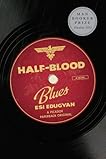 Half Blood Blues by Esi Edugyan
Half Blood Blues by Esi EdugyanMy rating: 3 of 5 stars
The story of Half-Blood Blues revolves around two African-American jazz musicians, Sid and Chip, as well as Hiero, a wunderkind half-German, half-Senegalese trumpet player. The action begins in 1939 Berlin and then moves between 1992 Berlin and Poland, and 1939 Paris.
Here’s what I loved about Half-Blood Blues: the crackling dialogue, the history, and the brilliant beginning of the novel. The cover is absolutely gorgeous, and once you develop an ear for the dialect, the book is quick to read.
Unfortunately, many things in Half-Blood Blues bothered me. As soon as the characters go into hiding from the Nazis, the pace crawls. Perhaps this tempo is a result of Sid the narrator becoming a passive observer of events. He just watches all the other characters take action. This passivity meant I couldn’t get a good sense of who Sid really was, and that affected how I perceived the relationships in the book. I did not get the feeling that he was particularly ambitious (one of the possible motivations in the story, but he gets over slights quickly) and I kept wondering what the story would be like if another character had told it.
I would have loved to have seen more of an exploration of identity, half-bloodedness (as the title suggests), and the irony that African-Americans went to interwar Europe to escape the racism back home. These elements are touched upon by Sid mentioning that some of his family pass for white, his girlfriend Delilah’s “mixed-race face”, and rival Hiero’s stories about who his father was. One of the telling details I really liked was the shocking visit to Hamburg’s Hagenbecks Zoo.
But there are many contradictory details: For example, Hiero carries his trumpet with him everywhere, then suddenly does not have it with him when they flee Berlin; Sid and Chip are able to give a history lecture to Louis Armstrong about German culture, but they don’t know that France has declared war on Germany. Also, the idea that a black man was able to live peacefully in a remote Polish village during communism, doesn’t jive with my experiences of visible minorities in Eastern Europe.
As well, Sid is aware that he speaks with a dialect and claims Hiero has transposed the dialect into German. But Hiero doesn’t understand English, so how does he create a Baltimore-German accent? It’s also linguistically questionable because German has a different syntax.
There are flashes of genius when the characters start to talk about friendship, love, art and sacrifice, but the heart of the discussion comes too late in the book and ends too soon.
Half-Blood Blues did give me with a chance to witness Nazi-occupied Europe through a new lens, but I find myself looking to Edugyan’s reading list at the end of the book, to help provide the grit and details of how a person like Hiero would have survived.
View all my reviews
No comments:
Post a Comment